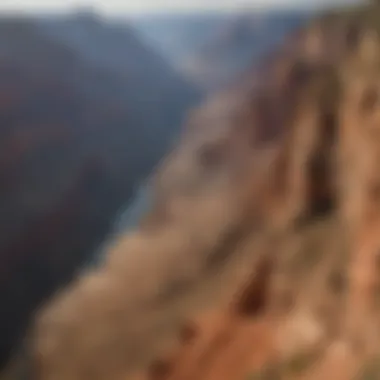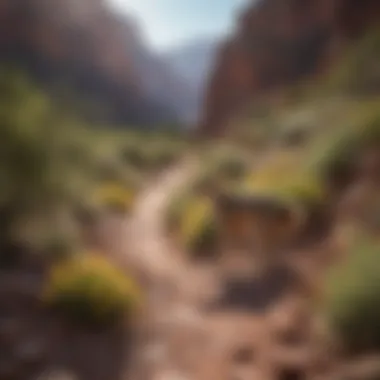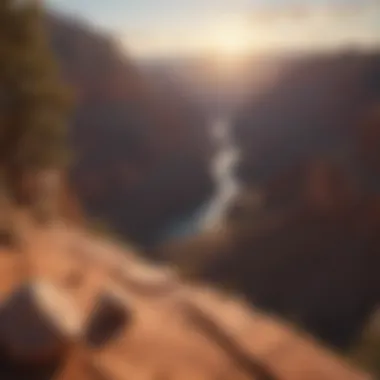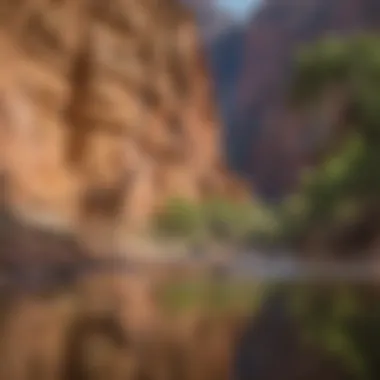Exploring the Grand Canyon: Geological and Ecological Wonders


Intro
The Grand Canyon represents a remarkable intersection of geological grandeur and ecological diversity. This vast chasm in northern Arizona, carved by the Colorado River, offers a window into the Earth's extensive history. Its layered rock formations chronicle billions of years of geological events. This article will delve into the complexities of the Grand Canyon's geology and its ecological significance, exploring the myriad species that inhabit this breathtaking expanse. Additionally, conservation efforts will be highlighted, underscoring the need for sustainable practices to ensure that this natural wonder endures for future generations.
Fascinating Facts About the Grand Canyon
- The Grand Canyon is over 277 miles long and approximately a mile deep.
- It is estimated that the canyon was formed between 5 to 6 million years ago, although its rocks date back nearly two billion years.
- The canyon hosts a variety of ecosystems, including desert, riparian, and forest habitats.
The varied landscapes of the Grand Canyon support more than 1,500 plant species and 447 species of vertebrates, including numerous birds and mammals.
Unique Characteristics
One of the Grand Canyon's defining features is its stratified rock layers, which showcase the Earth's geologic history. The different colored layers offer clues about the processes that shaped this environment over millennia. The sheer walls of the canyon create microclimates, allowing for unique flora and fauna adaptations.
Extraordinary Abilities
Many species that call the Grand Canyon home exhibit fascinating adaptations. For example, the California condor, one of the rarest birds in North America, has remarkable soaring capabilities, allowing it to cover vast distances in search of food. Similarly, the desert bighorn sheep has evolved to navigate steep cliffs and rugged terrains, showcasing incredible agility.
Behavior and Habitat
Natural Habitats
The Grand Canyon encompasses a diverse range of habitats. These include the Colorado River ecosystem, which nourishes riparian vegetation, as well as the arid plateaus that support desert species. Each habitat is crucial for wildlife survival and overall ecological balance.
Social Structures
Wildlife in the Grand Canyon exhibits various social structures. While some species, like bobcats, are solitary and territorial, others, such as mule deer, thrive in groups. This diversity in social behavior reflects the adaptations necessary for survival in different environments.
Recent Scientific Discoveries
Latest Research Findings
Recent studies have focused on the ecological impact of climate change on the Grand Canyon's biomes. For instance, shifts in temperature and precipitation patterns are influencing species distribution and interactions among flora and fauna.
Breakthroughs in Animal Biology
Research has unveiled significant insights into the reproductive habits of several species native to the Grand Canyon, revealing how their biological processes are intricately connected to their surroundings and seasonal changes.
Cultural Significance
Animals in Folklore
The Grand Canyon has a rich cultural history that is closely intertwined with the wildlife that resides there. Native American tribes often reference local animals in their myths and legends, illustrating their importance to their cultural heritage.
Influence on Art and Literature
Additionally, the awe-inspiring vistas and the wildlife of the Grand Canyon have inspired countless artists and writers. From John Wesley Powell's exploration narratives to contemporary photography, the canyon's beauty resonates profoundly in creative expressions.
Prolusion to the Grand Canyon
The Grand Canyon stands as a testament to the Earth's geological history and biological diversity. Many factors contribute to its importance as a subject of study, ranging from its breathtaking vistas to the intricate layers of rock that hold millions of years of Earth’s story. In this article, we aim to provide a detailed exploration of the canyon from both geological and ecological viewpoints. By examining these aspects, readers can better appreciate the delicate balance between nature's history and her present-day ecosystems.


Understanding the Grand Canyon allows us to comprehend the natural processes that shaped its formation, the unique species that inhabit its varied ecosystems, and the conservation efforts needed to preserve such a remarkable environment.
Geographical Overview
The Grand Canyon is located primarily in the state of Arizona, and it measures around 277 miles in length and reaches depths of over a mile. Its immense size and intricate structure showcase a dramatic landscape carved by the Colorado River over millions of years. The canyon’s steep walls expose nearly two billion years of geological history, with a variety of rock formations visible at different depths.
The climate within the canyon varies significantly based on elevation. The South Rim experiences more moderate temperatures, while the lower elevations face extreme heat during summer. This range of climatic conditions contributes to the rich biodiversity found within the canyon. From high desert scrub at the rim to riparian habitats along the river, each zone supports a unique array of flora and fauna, offering many opportunities for research and exploration.
Historical Context
The Grand Canyon has long been a significant site for both indigenous peoples and scientific research. Indigenous tribes, such as the Havasupai and Hopi, view the canyon as a sacred place, with rich cultural narratives tied to its formation. Their deep connection to the land has helped preserve traditional practices and knowledge that are essential to maintaining the ecological balance in the area.
In the 19th century, western scientific exploration brought the canyon to greater public attention. Many prominent figures, including John Wesley Powell, conducted expeditions that further documented its geological features and ecological diversity. Their efforts played a crucial role in advancing our understanding of the canyon’s significance, eventually leading to its establishment as a national park in 1919. This designation has helped protect its unique ecosystem while fostering continued research into its geological and ecological histories.
Geological Formation of the Grand Canyon
The geological formation of the Grand Canyon is a profound subject that reveals much about Earth's history. It serves as a natural archive, showcasing a timeline of geological events that span millions of years. An understanding of the canyon’s formation contributes not only to the fields of geology and ecology but also offers insights into climate change, erosion, and the natural processes that shape our environment. This section delves into the layered rock strata, erosion processes, and methods of dating that have contributed to this natural wonder's creation.
Layered Rock Strata
The Grand Canyon is famously characterized by its stunning layered rock strata. Each layer corresponds to different geological periods, which helps scientists interpret past environments. There are primarily four notable layers: the Vishnu Schist, which forms the canyon’s foundation; the Bright Angel Shale; the Muav Limestone; and the Grand Canyon Supergroup.
- Vishnu Schist: This ancient rock, dating back nearly 1.7 billion years, is primarily composed of metamorphic rocks. Its depth reveals the Earth’s crustal activity.
- Bright Angel Shale: This layer is about 500 million years old and indicates a shift in sediment types on the ocean floor.
- Muav Limestone: Formed around 490 million years ago, it presents a clear transition from marine to terrestrial environments.
- Grand Canyon Supergroup: This newer set of rocks, approximately 1.2 billion years old, includes various sedimentary units from different periods, illustrating the dynamic history of water and land interaction.
These layers are not just fascinating to study; they also represent significant natural resources and ecosystems.
Erosion Processes
Erosion is a major force in shaping the Grand Canyon, continuously carving the landscape. The forces at work include water, wind, and ice, which act collectively over millennia. The Colorado River is the primary agent of erosion, as its persistent flow has removed sediment and rock, creating the canyon’s breathtaking depth and width.
Key factors in the erosive processes include:
- Water Erosion: The constant movement of the river against the rock has created intricate formations, resulting in cliffs and rock faces.
- Weathering: Both physical and chemical weathering contribute to rock breakdown. Rainwater, for instance, can react with minerals and change the rock composition over time.
- Freeze-Thaw Cycles: In colder months, water can seep into cracks in the rocks. When it freezes, it expands and causes fractures, which accelerate erosion.
These processes are essential to maintain the dynamic landscape of the canyon, making it a living example of geological change.
Dating the Canyon’s Creation
Understanding the age of the Grand Canyon involves various dating methods. Geologists use techniques like radiometric dating and stratigraphic correlation to determine when the rock layers were formed and how the canyon evolved.
- Radiometric Dating: By analyzing isotopes within the rocks, scientists can ascertain their ages, providing insight into the timeline of canyon formation.
- Stratigraphic Correlation: This method involves comparing rock layers from different locations to draw conclusions about their relative ages and environmental conditions.
Estimates suggest the canyon itself began to form around 5 to 6 million years ago, though the rocks that compose it are much older. This contrast illustrates the complex nature of geological history, capturing a sense of deep time that defies human scales of existence.
Understanding the geological formation of the Grand Canyon goes beyond its visual majesty; it encapsulates the intricate interplay between time and nature, revealing histories that shape our planet.
In summary, the geological formation of the Grand Canyon not only illustrates the planet's evolution through its layered rock strata, but also highlights the relentless forces of erosion and the various methods used to understand its age. This ongoing story between geology and ecology forms the backdrop for the vibrant ecosystems that thrive within this awe-inspiring location.
Ecological Significance
The ecological significance of the Grand Canyon is immense. This region showcases a wide variety of ecosystems, providing crucial habitats for numerous species. Understanding the ecological frameworks present in the canyon helps to appreciate its biodiversity. Furthermore, the health of these ecosystems is closely tied to conservation efforts, highlighting the necessity for sustainable practices in preserving such an intricate environment.
Unique Flora and Fauna


The Grand Canyon is home to a diverse array of plants and animals. The unique geology creates various microhabitats, each supporting distinct species. The flora includes several endemic plants that contribute to the ecological richness of the area. Examples include the Grand Canyon yucca and the canyon live oak.
The fauna is equally rich. Over 447 species of birds have been recorded in the park, alongside 447 species of mammals, reptiles, and amphibians. This multitude creates a complex web of interactions essential for the stability of the ecosystem. Notably, the California condor, a species once on the brink of extinction, has found a sanctuary in this rugged terrain. The protection and restoration of these species are critical for maintaining the ecosystem's health.
Habitats within the Canyon
The Grand Canyon's habitats are diverse due to variations in elevation and climate. These variations give rise to different environments, from desert scrub at lower elevations to conifer forests at higher altitudes. Each habitat possesses its unique characteristics.
- Desert Scrub: This area supports drought-resistant plants like cacti and sagebrush, providing shelter for smaller mammals and lizards.
- Riparian Zones: Along the Colorado River, these lush areas support a variety of plant life and are crucial for many animal species seeking water.
- Ponderosa Pine Forests: Characterized by their tall trees, these forests provide habitat for larger mammals, like deer, and a myriad of bird species.
The connectivity of these habitats allows for the migration of species, ensuring genetic diversity and resilience against environmental changes.
Species of Interest
Several species within the Grand Canyon merit particular attention due to their ecological roles and conservation status. Some noteworthy examples are:
- California Condor: As one of the largest North American birds, the California condor plays a vital role in the ecosystem as a scavenger. Their recovery efforts include breeding programs to increase population numbers.
- Bighorn Sheep: These animals are adept climbers and are invaluable for promoting vegetation health through grazing, which maintains the balance within their habitat.
- Gila Monster: As one of the few venomous lizards in the world, Gila monsters are crucial in controlling insect populations. Protecting their habitat helps maintain this balance.
The ongoing efforts to study and protect these species is crucial for the overall health of the Grand Canyon ecosystem.
Wildlife Conservation Efforts
Wildlife conservation within the Grand Canyon ecosystem serves as a vital component in maintaining the delicate balance of its diverse habitats. This effort goes beyond simply preserving scenic beauty; it ensures the survival of numerous species that rely on this environment. The importance of wildlife conservation is multi-faceted. Firstly, it helps to protect the unique flora and fauna endemic to the region. Secondly, it safeguards the ecological integrity of the canyon, thereby ensuring that future generations can appreciate its grandeur. Lastly, engaging in conservation efforts can foster a sense of responsibility among visitors and local communities towards sustainable practices.
Current Conservation Programs
Several programs aim to protect wildlife in the Grand Canyon area. For example, the National Park Service has initiated habitat restoration projects that focus on both flora and fauna. These projects aim to restore areas that have been degraded by human activity. Additionally, organizations such as the Grand Canyon Conservancy work on various fronts, including education, research, and advocacy, to promote conservation strategies. These programs often include:
- Monitoring of species populations: Regular assessments help track the health of wildlife and their habitats.
- Invasive species management: Programs aim to control or eradicate non-native species that threaten local ecosystems.
- Community outreach campaigns: These educate the public about conservation issues and encourage sustainable practices.
Challenges to Biodiversity
Despite ongoing efforts, the Grand Canyon's biodiversity faces various threats. Climate change plays a significant role, causing shifts in temperature and precipitation patterns. This can impact species that rely on specific conditions for survival. Additionally, habitat fragmentation due to increased tourism and infrastructure development poses significant risks. The growing number of visitors can lead to overcrowding in sensitive areas, resulting in soil erosion, plant damage, and disturbance of wildlife. Other challenges include:
- Pollution: Runoff from nearby urban areas can contaminate water sources.
- Wildfires: Increased occurrences can devastate habitats and displace species.
Community Involvement in Conservation
Community engagement is crucial for successful conservation efforts. Local residents and visitors alike can play an active role in protecting the Grand Canyon’s wildlife. Many programs now emphasize helping communities understand the importance of their involvement. Volunteering in restoration projects or participating in local clean-up activities can foster a connection between individuals and the canyon.
Moreover, educational initiatives that focus on conservation can equip families with the knowledge needed to make environmentally responsible choices. Through partnerships with local schools, organizations can bring awareness to younger generations about the significance of wildlife conservation. Overall, strengthening community ties to conservation efforts can lead to a more sustainable future for the Grand Canyon's rich biodiversity.
"The value of wildlife conservation is not only in preserving the beauty of nature but in maintaining the essential balance needed for ecosystems to thrive."
Tourism and Its Impact
Tourism plays a significant role in the Grand Canyon's ecosystem and economy. It provides opportunities for education, conservation funding, and jobs for local communities. However, it also comes with its own set of challenges that impact the delicate balance of this natural wonder. Understanding these dynamics is crucial for both visitors and conservationists.
Visitor Statistics
Every year, millions of people visit the Grand Canyon. In 2022, about 4.5 million individuals explored the site, making it one of the most visited national parks in the United States. The peak tourist season runs from late spring to early fall when the weather is favorable. This influx generates substantial revenue through park entrance fees and nearby accommodations, supporting local businesses and contributing to the economy.
Yet, high visitor volumes can strain resources. Trails, campsites, and facilities often face overuse, leading to wear and degradation. The balance between welcoming visitors and maintaining the park's integrity is a constant challenge.


Sustainable Tourism Practices
Sustainable tourism practices are essential in mitigating the negative impacts brought by mass tourism. The National Park Service is implementing several initiatives to promote responsible visitation. These include:
- Education programs that inform guests about the environment and local wildlife.
- Leave No Trace principles that encourage minimizing human impact on sensitive areas.
- Wildlife monitoring to assess the effects of tourism on species behavior and habitat quality.
Through sustainable practices, visitors can enjoy the Grand Canyon while helping to protect its resources. Using public transportation or carpooling reduces carbon footprints. Engaging in guided tours led by knowledgeable locals can also enhance appreciation of the natural and cultural heritage of the area.
Potential Threats from Tourism
Despite its many benefits, tourism poses potential threats to the Grand Canyon. Overcrowding can lead to:
- Soil erosion, which compromises plant life and increases sedimentation in waterways.
- Wildlife disturbances as human presence alters natural behaviors, impacting nesting and feeding patterns.
- Pollution, both from litter and emissions, which can affect air and water quality.
Understanding these threats is critical for fostering a community that values conservation. Efforts are ongoing to balance human activity with ecological health. Park officials continue to look into innovative methods to manage visitor flow and provide sustainable solutions.
Sustainable tourism is not just about protecting the environment; it is also about preserving the unique experience the Grand Canyon offers.
Cultural Significance of the Grand Canyon
The Grand Canyon holds profound cultural significance that extends far beyond its breathtaking views and geological wonders. For many Indigenous peoples, this landscape is not just a physical site but a pivotal part of their heritage, spiritual beliefs, and identity. The cultural layers of the Grand Canyon provide insight into human history and the enduring connection between people and the land.
Indigenous Peoples and Their Connection
The Grand Canyon has been home to various Indigenous groups for thousands of years. Tribes such as the Havasupai, Hualapai, Navajo, and Hopi regard the canyon as sacred. Their connections to the land are woven into their cultural narratives, traditions, and spiritual practices.
These communities have a deep understanding of the ecosystem, having lived in harmony with its resources. Knowledge about medicinal plants, animal behaviors, and water management has been passed down through generations. The Grand Canyon serves as a symbol of resilience and cultural continuity, binding these tribes to their ancestors and the natural environment.
“The canyon is not just a place to visit; it is a part of our people’s history.” - Hualapai elder
Artistic Representations of the Canyon
Over the years, the Grand Canyon has inspired countless artists, writers, and musicians. Its vastness and beauty have been captured in various forms, ranging from traditional indigenous art to contemporary pieces. Artistic representations often highlight the unique colors and shadows of the canyon, showcasing its grandeur while also embodying the messages of those who understand its deeper significance.
- Traditional Art: Indigenous artists frequently use native materials to create works that symbolize their relationship with the land. Pottery, weaving, and carvings reflect the cultural narratives passed through generations.
- Contemporary Interpretations: Modern artists use the Grand Canyon as a canvas to explore themes of nature, conservation, and human impact on the environment. This dialogue is essential in raising awareness about ecological issues and advocating for the preservation of this natural wonder.
The cultural significance of the Grand Canyon is multi-faceted, linking the past and present while championing cultural identity. This space is a rich tapestry of history, spirituality, and artistic expression that continues to inspire both Indigenous peoples and the broader public.
End: The Importance of Preservation
Preservation of the Grand Canyon is vital not only for its natural beauty but also for the ecological balance it supports. As one of the world’s most intricate ecosystems, the Canyon hosts unique species of plants and animals and offers critical habitats that are irreplaceable. Addressing the preservation of this landscape is essential for maintaining the health of these ecosystems and the communities that depend on them.
Future Challenges for the Grand Canyon
The Grand Canyon faces a variety of challenges that threaten its ecological integrity. Climate change is particularly concerning, as it leads to altered weather patterns affecting both flora and fauna. Increased temperatures and droughts may disrupt the delicate balance that these species rely on. Additionally, invasive species can outcompete native species, leading to a decline in biodiversity.
Urban development surrounding the Canyon also poses significant risks. Expanding infrastructure can degrade natural habitats, leading to habitat fragmentation. Furthermore, increased tourism and human activities result in additional strain on local wildlife and natural resources.
Efforts in monitoring and research are essential to understand how these challenges shift over time. Strategies for restoration and conservation need constant revision to adapt to these evolving threats, ensuring that future generations can enjoy the Grand Canyon's splendor.
Final Thoughts on Ecological Balance and Conservation
Maintaining ecological balance within the Grand Canyon is a formidable task. Conservation is not merely about protecting the Canyon's visible attractions; it also involves understanding the complex interactions among species, their habitats, and their environment.
Effective conservation strategies include engaging the local communities and Indigenous peoples who have a deep-rooted connection to this land. Education about sustainable practices is crucial. By fostering a sense of stewardship among visitors and residents, it is possible to promote a collective responsibility towards safeguarding this natural wonder.
"The preservation of natural landscapes is not just about beauty; it is about preserving the fundamental fabric of life."
As we reflect on the Grand Canyon's significance, it becomes clear that its future relies heavily on our commitment to conservation and ecological understanding. By prioritizing these efforts, we ensure an enduring legacy of knowledge and admiration for this incredible landscape.







